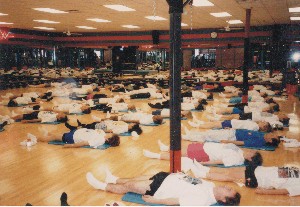Stay Healthy with Yoga by Bharati Amin
The word Yoga, derived from the Sanskrit word Yuj—meaning to join, yoke, or concentrate — is the evenness of the mind. The physical aspect of Yoga is known as Hatha Yoga, although it is generally just referred to as Yoga. Breathing exercises in Hatha Yoga are known as Pranayama— the science of breath control.
Yoga is a science of health. It not only helps keep a healthy and strong body in strenuous conditions, but also helps retain mental balance. Yoga is not merely a system of physical exercises but a complete way of life. It helps one remain healthy in any adverse condition and retain mental balance in any difficult situation. In essence, Yoga can help you attain a life full of harmony, one that is enjoyable and worth living.

Yogic exercises, known as asanas, are postures that have a beneficial effect on the body's circulatory, respiratory, cardio-vascular, digestive, excretory, and central nervous systems as well as the glands. Yoga improves the flexibility of muscles, bones, and ligaments too. It also improves the nutrient cycles of digestion, respiration, and circulation which nourish and service every cell and tissue as well as the vital messenger systems of nerves and hormones which balance and regulate our physical, emotional, and mental responses. Yoga, unique among all forms of body-culture, works systematically on all these parts of the living body to keep them functioning in balance and in perfect condition.
The physical body is only one aspect of health in Yoga. Philosophy, mind, and spirit are just as important. Western medicine too has begun to understand that the mind must heal for the body to mend. But the western approach is piece-meal, whereas Yoga integrates the science of mind, body, and spirit. If your nervous and endocrine systems are healthy, the body and mind will respond positively to any demand or threat, and quickly return to normal functionality.

Yogic exercises combined with breathing exercises can cure the sinuses, cough, cold, headaches, and asthma. It also helps cure stomach problems such as indigestion, acidity, constipation, and ulcers. In addition, it gives relief from back, neck, shoulder, and knee pains as well as sciatica, arthritis, and rheumatism. Yoga has even helped patients with diabetes, cancer, and heart trouble. Doing Yoga and Pranayama increases stamina, vigor, stretchability, height, endurance, resistance to diseases, weight-control, memory, concentration, and will-power. Moreover, Yoga eliminates stress, strain, hypertension, and cholesterol, which is why some recommend "to keep Yoga in, and trouble out."
Hatha-Yoga exercises can be done by adults and children of any age. It requires no special equipment—just yourself! So, come try these life-long exercises for your health and well-being today.
Caution: Those suffering from any serious disorder should undertake exercises at their own responsibility. Persons with weak heart or lungs, or those with high blood pressure should consult with their doctor first.